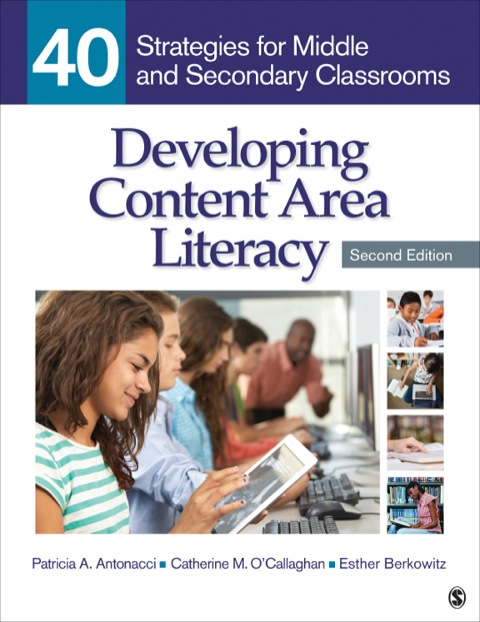Description
Efnisyfirlit
- Cover Page
- Halftitle
- Dedication
- Title
- Copyright
- Contents
- Preface
- Acknowledgments
- Common Core Anchor Standards for Reading
- Section I: Academic Vocabulary: Developing Vocabulary for Learning in Content Areas
- 1 Semantic Mapping: Developing Robust Academic Vocabularies
- 2 Vocabulary Self-Collection Strategy: Promoting Word Consciousness
- 3 Contextual Redefinition: Using Clues as a Word-Learning Strategy
- 4 Semantic Feature Analysis: Comparing and Contrasting Features of Words
- 5 Blogging Academic Vocabulary: Integrating Subject-Matter Discourse Into Media
- Section II: Reading Fluency: Developing Deep-Reading Fluency
- 6 Readers Theatre: Increasing Fluency Through Student Engagement With Text
- 7 Paired Reading: A Collaborative Approach for Developing Deep-Reading Fluency
- 8 Audiobooks: Modeling and Scaffolding Reading Fluency
- 9 Radio Reading: An Authentic Approach for Developing Reading Fluency
- 10 Morphemic Analysis: A Useful Resource for Becoming a Fluent Reader
- Section III: Developing Close Reading of Text: Essential Strategies for Teaching Close Reading
- 11 Annotation: Strategic Analysis of Text
- 12 Interactive Think-Alouds: Collaborative Interpretation of Text
- 13 Inference Strategy Guide: Facilitating Reading Between the Lines
- 14 The Inquirer Strategy: Learning to Ask Questions
- 15 Active Interpretation of Film: Making Inferences Through Visual Media
- Section IV: Reading Informational Text: Developing Comprehension for Informational Text
- 16 Questioning the Author: Constructing Meaning From the Text
- 17 Text Structure Strategy: Using Graphic Organizers to Learn From Informational Text
- 18 Connect to It: Making Personal, Text, and World Connections to Text
- 19 Inquiry Charts: Organizing Information for Learning From Texts
- 20 Digital Pattern Folders: Comprehending Multimodal Texts
- Section V: Media and Digital Literacies: Developing Comprehension for Media and Digital Literacies
- 21 Think and Check: Contextualizing and Corroborating Online Information
- 22 Digital Storytelling: Creating Digital Text
- 23 Wikibooks: Collaborative Research Projects
- 24 Podcasting: Merging Media for Understanding
- 25 Book Trailers: Insights and Discoveries About Texts
- Section VI: Critical Thinking: Developing Students’ Critical Thinking Skills
- 26 SCAMPER: Collaborative Analysis of Text
- 27 Six Thinking Hats: Facilitating Different Modes of Thinking
- 28 Academic Controversy: Taking Sides on the Issue
- 29 Three-Level Reading Guide: Developing Literal, Interpretive, and Applied Reading of Text
- 30 Request Reciprocal Teaching: Collaborative Critical Thinking
- Section VII: Writing Informational Text: Developing Writing in the Content Areas
- 31 Concept Star: Visualization for a Prewriting Strategy
- 32 Concept Mind Map: Facilitating Collaborative Writing
- 33 Research for Choice: Facilitating Student Voice in Academic Writing
- 34 Shared Pen: Interactive and Collaborative Writing
- 35 Targeted Text: Guided Writing of Informational Text
- Section VIII. Independent Learning Strategies: Promoting Strategies for Independence in Learning
- 36 Talking Around the Text: Using Dialogic Reading and Writing to Promote Independent Learners
- 37 Textbook Activity Guide: Developing Independence in Learning From the Textbook
- 38 Academic Note Taking: Supporting Students’ Independence in Learning
- 39 Entrance and Exit Slips: Helping Students to Reflect on Their Learning
- 40 Journaling: Helping Students to Respond, Reflect, and Learn Through Informal Writing
- Index
- About the Authors
- Advertisement






Reviews
There are no reviews yet.